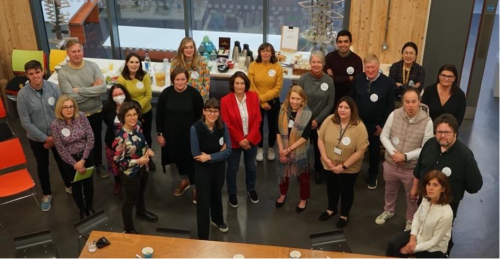In May we held a workshop at Imagination exploring how design might be used in the creation of Place Based Policy. The workshop was funded by the Beyond Imagination project and we invited people from local and national government, researchers and designers from around the country. The team from Policy Lab also attended (read their blog about Place-Based Policy here).
The aims of the workshop were to:
- Explore the emergent area of place-based policy making
- Understand what we mean by place
- Explore how design can be embedded in place-based policy making
- Questioning whether we need to develop new design tools and methods in this area
- Establish a way forward and create an agenda for future work

Workshop participants
What is Place-Based Policy?
Policy makers face challenges in tackling complex problems, such as climate change, post COVID-19 recovery, and ensuring equitable access to services. These issues are experienced in different ways in different places, and ‘one size fits all’ policy approaches are not always the most suitable.
The idea of place-based policy is becoming more important to governments at all levels in this country and is seen as a way in which to make policies based on the needs of a particular place and those who live there. This approach has been at the centre of the government’s ‘Levelling Up’ agenda, which aims to give more power to local policy makers and communities. Some of our attendees came from Policy Lab, based in central Government and wrote a blog about the workshop and their work in this area which you can read here
In our research, we have found that what is meant by and understood by ‘place’ is not always made clear. We have also found that design methods and tools offer policy makers opportunities to think more creatively about policy making and to engage a wider range of communities in decision making.
Policies are always located within a place, and are influenced by the geographical, political, and administrative borders they lie within. National policies must work alongside the local, which can lead to tensions between political parties, those who must implement the policies and those who are impacted them.
In recent years the concept of place-based policy has emerged as a way in which policies can be developed by taking a ‘place-up’ approach, which recognises that not all policies will work in all areas. As we emerge from the COVID-19 pandemic, which had profoundly different effects in different places, and feel the effects of the cost-of living crisis, climate change, and challenges to education and healthcare, it is vital that policies are designed to tackle these complex issues so that they are fit for purpose and understand the specific challenges faced in different places.
Place-based policies recognise that “Place emphasises human experience and subjective view on development and change … This is critical for place-based policy because it speaks to the motivations of individuals and groups. It draws our attention to a specific location, its institutional settings, and meanings for people” (Beer et al, 2020). This move towards understanding how a particular place and those that live there are impacted by policy is an opportunity for us to explore how design can be of use in engaging people and policymakers.
Workshop outcomes
At the end of the workshop we created a Manifesto for design in place-based policy:
A manifesto for design in place-based policy
GOALS:
- Develop a White paper on Design in Place-Based Policy to inform policy and in turn provide legitimacyto this area of work
- Build a cohesive and persuasive argument for design in place-based policy
- Explore R&D opportunities within and between government at all levels and academia
- Inspire, challenge and advance knowledge in design in place-based Synthesise underlyingtheories (e.g., more-than-human design) and bring together academics across disciplines, including political science, local government, and policy studies
- Develop funding and strategic development opportunities between government and academia
- Create a database of impact projects in the area of design and policy have had
- Develop a network of active practitioners and researchers in government, academia, and design practice to share learning, tools, and ways of working
ACTIONS:
- Identify wider and existing networks of people working in design, policy, and wider place-based policy
- Understand policy context at all scales of governance in the UK
- Translate and communicate the research agenda between government and academia
- Identify areas for funding and strategic development between government and academia
- Develop a network to connect around specific policy areas (e.g., net zero, housing) to be readystrategically for funding
- Develop a hypothesis that we want to test through research and choose small test-beds
- Produce insights and evidence base for range of audiences
- Create a network of excellence in design for place-based policy
Report: The report from the workshop can be found here
Next steps
The exploration of design in place-based policy is emerging as a rich area of research and practice. This workshop highlighted not only the interest in this area from a range of organisations and individuals, but also thepotential for significant impact. From the findings of the workshop, we intend to develop a position paper in Design for Place-based Policy. We also intend to develop a research bid, which will enable us to develop the network, based upon the participants who attended this workshop.
References:
Beer, A., McKenzie, F., Blazek, F., Sotarauta, M., Ayres, S (2020) Towards Effective Place-Based Policy, Taylor& Francis Group
